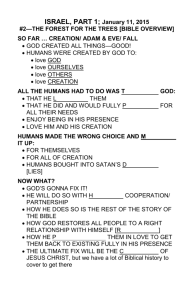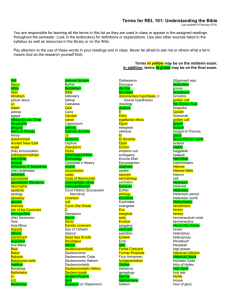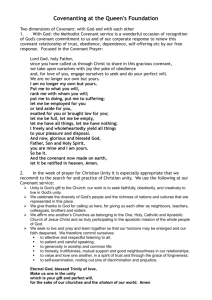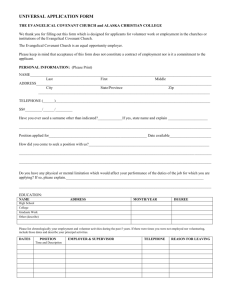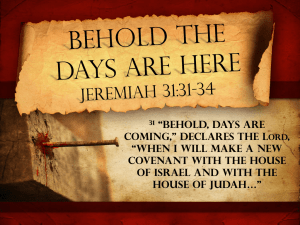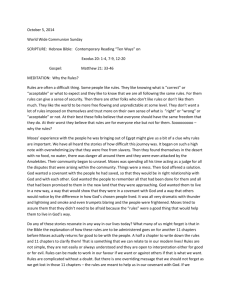The Biblical Covenants - Berachah Bible Church
advertisement
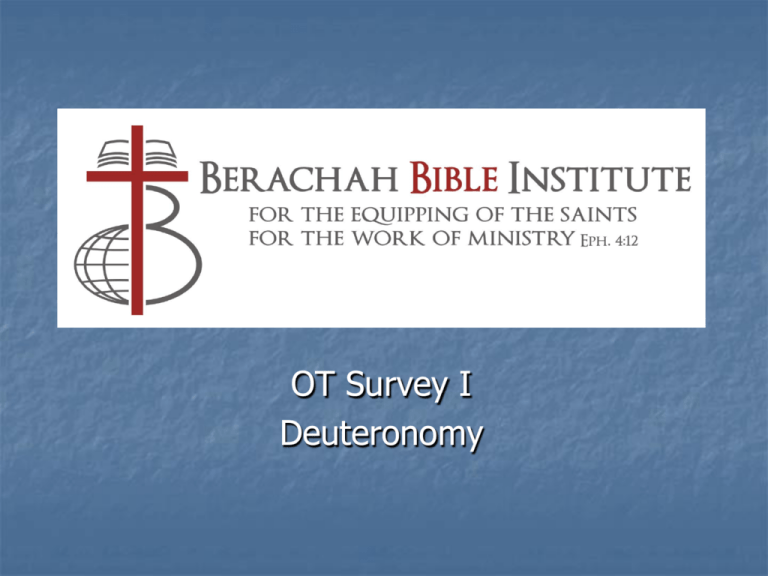
OT Survey I Deuteronomy A Quote from Paul House By any standard of comparison Deuteronomy is one of the most important books in the canon. Its historical setting links the Sinai and wilderness experiences with the conquest of Canaan and provides a transition from Moses’ leadership to Joshua’s. Its canonical placement concludes the Pentateuch by effectively interpreting Exodus, Leviticus and Numbers; yet it also provides an interpretive framework for the Former and Latter Prophets (Joshua – Malachi). Its theological emphases set the tone for how Israel must live in the land they will inherit from the God who has chosen them. Its exhortative, instructional style offers rhetorical patterning for Old Testament historians, prophets, psalmists and sages. Beyond the Hebrew canon, Deuteronomy is, with Genesis, Psalms and Isaiah, one of the four most-quoted Old Testament books in the New Testament. Jesus himself uses passages from Deuteronomy to resist Satan’s temptations in Matthew 4:1-11. Unquestionably this book, the Pentateuch’s capstone, deserves careful theological analysis (Old Testament Theology, p. 169). Setting The book of Deuteronomy takes place over a period of about 1 month in the plains of Moab, in the fortieth year after God delivered Israel from Egyptian bondage (c. 1405 BC). Basic Structure Moses Reviews Israel’s Journey from Sinai to the Plains of Moab (chaps. 1 – 4) Moses Reviews and Expands the Law for the New Generation (chaps. 5 – 26) Moses Reviews Israel’s Covenant Relationship with God (chaps. 27 – 30) The Final Ministry of Moses (chaps. 31 – 34) Format of the Deuteronomic Covenant – Suzerain/Vassal Treaty Preamble (1:1-5) Sets out the occasion and setting of the covenant. Historical Prologue (1:6-4:49) Narrates Israel’s journey from Sinai to the plains of Moab, especially noting instances of Israel’s rebellion (1:26-28, 32; 3:26) and God’s righteous retribution (1:34-40, 45; 2:1415; 4:3). The purpose of the section is to make clear God’s claim on His people. Despite their disobedience, God had not forsaken them and had brought them to the present time and place in order that He might reaffirm His covenant with them. General Stipulations (5:1-11:32) Spells out the principles that govern the relationship between the parties of the covenant and clarifies who the Great King is, what He has already done and will do for His people, and how the people are to respond. Deut 6:4-5 is especially significant. Specific Stipulations (12:1-26:15) Provides specific case laws that are grounded in the Shema and the commandments of the Decalogue and are intended to be applied to various situations in life. Blessings and Curses (27:1-28:68) Provides promises of blessing for obedience to the covenant stipulations and promises of curses or punishments for covenant disloyalty. Parallels Leviticus 26. Witnesses (30:19; 31:19-21) Calls upon heaven and earth as witnesses to this covenant between Yahweh as His people (Deut 30:19). Major Themes Review of Events and Covenant relationship The Character of Yahweh Unique and Jealous Near and Transcendent Faithful Loving Gracious Judging The Requirements for Israel Includes references to the Abrahamic and the Mosaic Covenants Fear and love Yahweh Keep Yahweh’s commands/hear and obey Blessings for Obedience, Punishment for Disobedience Possession of the land The End of Moses’ Leadership Purpose Statement Moses exhorted Israel to be faithful to the covenant God made with her at Sinai, so that she might go in and possess the land. Essence of the Deuteronomic Covenant It is a renewal of the Mosaic Covenant with a new generation. It spells out who Yahweh is, what He has done, and what He requires of His people. It promises blessing for obedience and curses for disobedience, with the ultimate curse being exile from the land. It promises that, despite their disobedience, God would not forsake His people but would restore them from exile when they repented. The Deuteronomic Covenant and the Rest of the OT The remainder of the OT is an outworking of the Deuteronomic Covenant. The book of Joshua records the initial conquest of the land, which broke all major resistance by the enemies of the Israelites. Each tribe was then responsible to go in and drive out the inhabitants of its allotted portion, a task which most failed to do. As time passes, Israel is influenced towards idol worship and other covenant violations by those that the Israelites had failed to drive out. God punishes her and eventually takes her out of the land, just as He said He would. But even as Israel and Judah are taken into captivity, God assures them through the prophets that they will eventually be restored, again in accordance with the promise of the Deuteronomic Covenant (Deut 30:1-10). Interpretive Issue A separate Palestinian Covenant? No; Deut 29:1 (28:69 in the Hebrew text) concludes what has come before, rather than introduces what follows. “Besides” makes a distinction between the Deuteronomic Covenant and the Sinaitic Covenant. No covenant legislation in chapter 29. The covenants referenced in chapter 29 are the Deuteronomic Covenant (29:9, 12, 14) and the Mosaic Covenant (29:25). There are no later references to a Palestinian Covenant in the OT. Next Time Overview of Historical Books & the Book of Joshua
